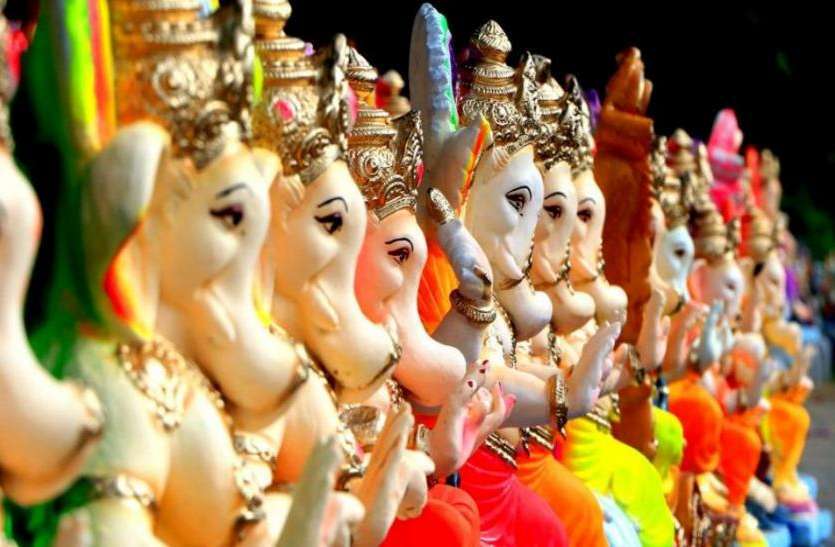Different Forms of Ganesha
Lord Ganesha, the very names means name means “Lord of the Ganas”- small, mischievous dwarfs with round bellies who serve Ganesha and his famous father, Shiva. Lord Ganesha is worshipped widely by people of different faiths throughout India, Southeast Asia, and around the world. Also called the Lord of Beginnings and the Lord of Obstacles, Ganesha can create challenges, but even more, he can remove them or help people overcome them. People pray to Ganesha to bring them good luck, especially when starting something—such as a journey, a business, a marriage, or a new year—or when facing something difficult, like taking an exam or performing a dance.
The various forms of Ganesha have various meanings into it. Let us look into them…
Usual Idol: The sculpture of Shri Ganapati is given in the Shri Ganapatyatharvashirsha as ‘Ekadantam, Chaturhastam’, meaning, He who is ekadanta, is chaturbhuja (Has four hands), bears a pash (Noose) and an ankush (Goad), holds a (broken) tusk in one hand and holds the other hand in a varadmudra, whose flag bears the symbol of a mouse, who has a red complexion, lambodar (Has large abdomen), whose ears are like sifting pans, who is adorned in red clothes, whose body is smeared with a paste of raktachandan (Red sandalwood) and who is worshipped with red flowers.
Variations in Idols of Lord Ganesh
Mudra: Sometimes one comes across Ganapati Idols in padmasan (A lotus posture) or at times even in nrutyamudra (A dance posture).
Mundkata (Beheaded) Ganesh: There is a Mundakata Ganesh Idol in the Himalayas. The Name itself suggests that this Idol is without the head. It is said that this is the Idol of the son who was created by Devi Paravati from the grime of her body and who was later beheaded by Deity Shankar.
Other complexions: Haridraganapati and the Urdhvaganapati have a yellow complexion. The Pingalaganapati is tawny, while Shri Lakshmiganapati is white in complexion.
Feminine form: In the Shakta sect, Shri Ganapati is worshipped in the feminine form. Some such examples are given ahead.
· Ganeshwari : An extremely attractive sculpted Idol of Ganeshwari is found in the Suchindram temple in Tamil Nadu.
· Ardha Ganeshwari : It has a highly meaningful form in the Tantra path of spiritual practice.
· Ganeshani : This female Deity is found in an extremely rare form of tantrik-mantrik worship.
Types of Ganpati Idols
There are several types of Ganapati Idols such as, the Soumyaganapati, Balaganapati, Herambaganapati, Lakshmiganapati, Haridraganapati, Uchhishṭaganapati, Suryaganapati, Varadaganapati, Dwibhujaganapati, Dashbhujaganapati, Nartanaganapati, Uttishṭhitaganapati, Ganapati with the trunk curved towards the right etc.
Implied meaning of various parts of the Idol
Entire Idol: Omkar, nirgun (Non-materialised)
Trunk: Trunk curved towards the right : An Idol of Ganapati with the trunk curved towards the right is called Dakshinamurti or Dakshinabhimukhi murti. Dakshina refers to the southern direction or the right side. The southern direction leads to the region of Yama, the Deity of death, while the right side belongs to the Suryanadi (Sun channel). He who can face the direction of the region of Yama is powerful. So also, he with an activated Suryanadi is also radiant. Thus, in both senses, the Ganapati Idol with the trunk curved towards the right is said to be ‘jagrut (Awakened)’. Scrutiny of our demerits and merits is carried out in the region of Yama, that is, in south direction and hence, that direction is repulsed. The scrutiny akin to that done in the south region after death begins when alive, if one sits facing the south (or sleeps with the legs directed towards the south). The Dakshinabhimukhi Idol is not worshipped ritualistically in the usual manner because tiryak (or Raja) waves are emitting from the south. The ritualistic worship of such an Idol is performed by strict abidance of all the norms of ritualistic worship scrupulously. Consequently, the sattvikta (Purity) is augmented and the distress by the Raja-Tama waves coming from the south is prevented.
Ganesh Trunk curved towards the left: An Idol with the trunk curved towards the left is called Vamamukhi Ganapati. Vam means the northern direction or the left side. The Chandranaḍi (Moon channel) is situated to the left. It bestows tranquillity. Besides, the northern direction, conducive for Spirituality, is Anand (Bliss)-bestowing; hence, mostly the Vamamukhi Ganapati is worshipped. It is worshipped ritualistically in the usual manner.
Modak: Modak means Anand in a small portion. A modak is shaped like a coconut, that is, like the cavity ‘kha’ in the Brahmarandhra. When Kundalini reaches the ‘kha’ cavity, it gives the spiritual experience of Anand. Modak held in the hand signifies Anand-bestowing Shakti.
Ankush: It is the destroyer of the energies, which are harmful to the mission of acquisition of spiritual knowledge and Anand.
Pash: Shri Ganapati is one who will tie the noose around negative entities and take them away.
Serpent wound around the waist: The Universal Kundalini.
Hood of the serpent: Activated Kundalini.
Mouse: Mouse implies that the component king is under the control of Shri Ganapati.
@religionworldin
[video_ads]
[video_ads2]












